The Dialysis Equipment Industry Analysis in the United States is estimated to be valued at USD 6.6 billion in 2025 and is projected to reach USD 8.8 billion by 2035, registering a compound annual growth rate (CAGR) of 2.9% over the forecast period.
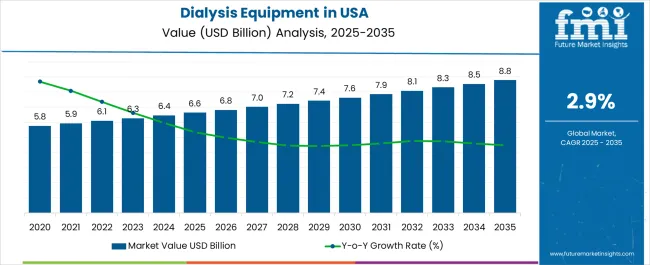
| Metric | Value |
|---|---|
| Dialysis Equipment Industry Analysis in the United States Estimated Value in (2025 E) | USD 6.6 billion |
| Dialysis Equipment Industry Analysis in the United States Forecast Value in (2035 F) | USD 8.8 billion |
| Forecast CAGR (2025 to 2035) | 2.9% |
The dialysis equipment industry in the United States is advancing steadily, driven by the increasing prevalence of kidney-related disorders, rising awareness of early treatment, and the presence of a highly developed healthcare infrastructure. Current market conditions reflect strong demand for technologically advanced devices, supported by regulatory approvals and consistent reimbursement frameworks that enhance accessibility. Patient demographics, particularly the growing geriatric population, have further accelerated demand for long-term dialysis solutions.
The future outlook is shaped by continuous innovation in equipment design, integration of digital monitoring systems, and expansion of outpatient dialysis centers, which are improving treatment efficiency and patient outcomes. Growth rationale is supported by the emphasis on reducing hospitalization rates, the shift toward home-based care in selected patient groups, and strategic investments in research and development by leading manufacturers.
As precision healthcare and value-based care models gain traction, the USA dialysis equipment industry is positioned for consistent revenue growth and expanded adoption across diverse care settings.
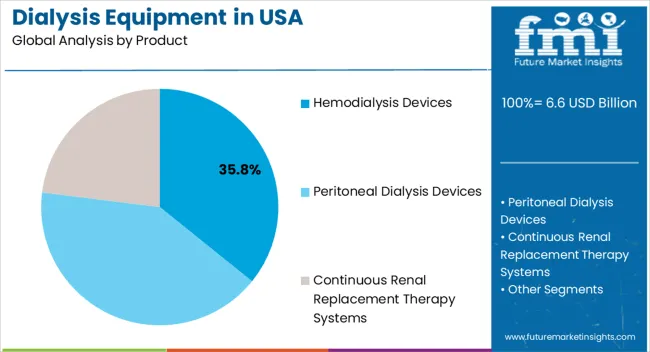
The hemodialysis devices segment, accounting for 35.80% of the product category, is maintaining leadership due to its wide applicability in both clinical and home care environments. Adoption has been strengthened by advances in filtration technology and improved vascular access systems, which enhance treatment safety and efficiency.
Demand has been reinforced by the established presence of dialysis centers across the United States, coupled with a reliable supply chain for critical consumables. The segment has benefitted from favorable reimbursement structures and clinical guidelines prioritizing hemodialysis as a standard modality for patients with end-stage renal disease.
Continuous upgrades in machine design, portability, and integration with digital monitoring platforms are driving adoption These advancements, together with strong institutional procurement and patient trust in the modality, are expected to support sustained growth and secure its continued dominance within the dialysis equipment landscape.
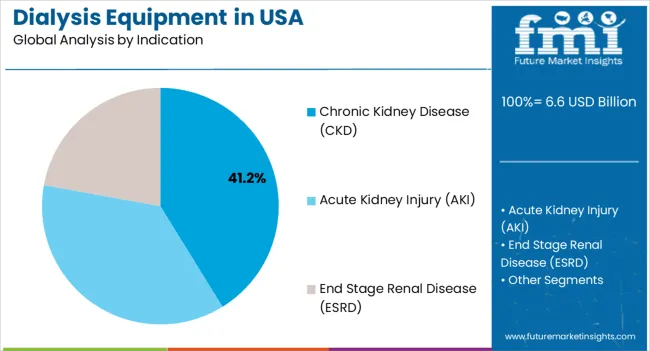
The chronic kidney disease (CKD) segment, representing 41.20% of the indication category, has emerged as the dominant driver due to the high prevalence of CKD across the USA population. Its leading share is being supported by early diagnosis initiatives and structured clinical pathways that guide patients toward timely dialysis intervention.
Adoption has been reinforced by the increasing incidence of lifestyle-related risk factors, such as diabetes and hypertension, which have expanded the CKD patient pool. Healthcare providers are emphasizing consistent treatment adherence and preventive monitoring, which is sustaining demand for dialysis equipment.
The segment has also been supported by government-led programs aimed at addressing kidney health, thereby improving access to dialysis solutions Long-term patient management requirements, combined with the expansion of specialized treatment centers, are expected to ensure continued dominance of CKD indications in driving dialysis equipment adoption.
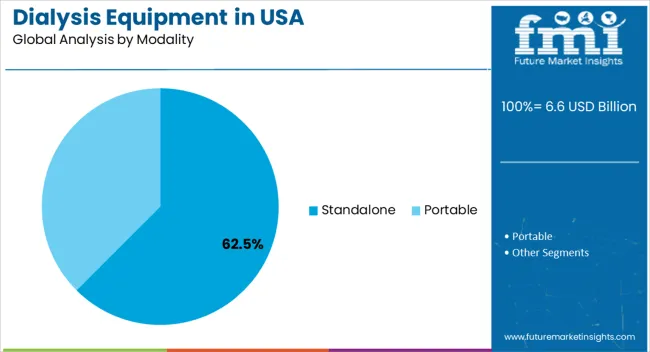
The standalone modality segment, holding 62.50% of the modality category, has secured leadership due to its extensive use in hospital and outpatient dialysis centers across the United States. Preference for standalone systems has been sustained by their reliability, capacity to handle multiple patients, and compatibility with a broad range of treatment protocols. Healthcare facilities have relied on these systems to manage large patient volumes, ensuring consistent throughput and operational efficiency.
Robust installation bases and established maintenance networks have further reinforced adoption. Advancements in user-friendly interfaces, automated monitoring, and enhanced safety controls have elevated patient care standards, thereby supporting segment growth.
As the need for efficient and scalable dialysis infrastructure continues to expand, standalone systems are expected to maintain their competitive advantage and remain the cornerstone of the USA dialysis equipment industry over the forecast horizon.
Revenue to Expand Over 1.3X in the United States through 2035
Revenue in the United is predicted to expand over 1.3X through 2035, amid a 0.5% increase in anticipated CAGR compared to the historical one. This is due to rising incidence of kidney diseases and rising demand for advanced dialysis treatments.
Other Factors and Trends in the United States Dialysis Equipment Business Shaping Growth include:
Sales of dialysis equipment in the United States recorded a CAGR of 2.5% from 2020 to 2025. Total valuation at the end of 2025 reached about USD 6,252.5 million. Over the forecast period, the United States dialysis equipment business is set to thrive at 3.0% CAGR.
| Historical CAGR (2020 to 2025) | 2.5% |
|---|---|
| Forecast CAGR (2025 to 2035) | 3.0% |
Growing demand for dialysis amid increasing cases of kidney diseases, including CKD and ESRD, is expected to boost the dialysis equipment business. Dialysis systems are increasingly used in blood purification and the removal of extra fluid.
The United government strives to provide easy access to treatments for kidney patients. It is investing vast amounts in upgrading hospital infrastructure and technologies. This is expected to create growth prospects for dialysis equipment manufacturers.
Companies and researchers are trying to introduce novel dialysis systems with enhanced features. For instance, they are focusing on developing wearable dialysis machines that are convenient to use and free patients from the otherwise huge machines that keep them tied down.
Several companies in the United States are developing different types of wearable kidneys. These include devices for hemodialysis and peritoneal dialysis and one machine that combines both hemodialysis and peritoneal dialysis.
The new devices weigh less and have small parts fitted with long-lasting batteries and filters that can reuse dialysate without needing a lot of purified water. These advances make it possible for people to wear a dialysis device that isn’t very heavy and can be worn under clothing.
Manufacturers see an opportunity to connect symptoms and treatment algorithms. This is because they focus on the Advancing American Kidney Health Initiative’s goal of placing new dialysis patients on home dialysis in the coming years.
With government-supported programs like KidneyX, manufacturers see redesigning dialysis machines and connective health as ways to make treatments easier for patients and to provide useful data to clinicians. This will help them to boost their revenue and solidify their positions.
Healthcare organizations in the United States are taking several initiatives to reduce the burden of kidney diseases. For instance, in July 2024, HHS and ASN formed the KidneyX Innovation Accelerator (KidneyX). This partnership aims to disrupt the status quo and offer new hope to millions worldwide with kidney diseases. Such developments are expected to foster growth.
Growing prevalence of chronic diseases is prompting manufacturers to develop innovative dialysis products to meet customers’ demands. Thus, growing research and innovation of new products will offer lucrative opportunities for dialysis equipment manufacturers through 2035.
Overview of Restrictive Factors for the Dialysis Equipment Business
Kidney transplantation is one of the alternate treatment options for patients suffering from end-stage renal kidney disease. The better treatment outcomes associated with kidney transplants and affordability of the procedure, owing to the favorable reimbursement policies, are projected to impede the growth of the dialysis equipment business during the forecast period.
Patients diagnosed with ESRD prefer kidney transplantation over renal infusion owing to the long-term benefits associated with the procedure. Thus, growing preference for alternate treatment options over dialysis is expected to hamper the business’s growth in the coming years.
The need for frequent treatments makes dialysis a high-cost procedure that imposes a financial burden on patients. This may lower the adoption of the treatment.
The table below highlights the anticipated growth rates of different regions in the United States. Among these, Midwest and Southwest regions are set to register higher with CAGRs of 4.9% and 4.1%, respectively.
| Regions | Value-based CAGR |
|---|---|
| Northeast United States | 3.2% |
| Midwest United States | 4.9% |
| Southeast United States | 1.8% |
| Southwest United States | 4.1% |
| West United States | 2.5% |
The Southeast United States dominates the target business with a 34.5% value share in 2025. Over the forecast period, demand for dialysis equipment in the Southeast United States is predicted to rise at 1.8% CAGR.
Rising prevalence of chronic kidney diseases (CKD) is a prominent factor expected to drive dialysis equipment demand in the Southeast United States. As the number of patients requiring dialysis increases, so does the need for advanced and efficient equipment.
The Southeast United States is also witnessing increased investments in healthcare infrastructure, including dialysis centers and hospitals. Infrastructure development can support the integration of the latest dialysis equipment and technologies. This will likely boost sales of dialysis equipment in the region.
The West United States is expected to hold a value share of 23.0% in 2025. It will attain a valuation of USD 1,913.6 million in 2035, with dialysis equipment sales growing at 2.5% CAGR throughout the assessment period.
Multiple factors are expected to drive sales growth in the West United States. These include rising popularity of home healthcare and growing adoption of portable dialysis equipment.
Integrating telehealth solutions in the West United States for remote monitoring and management of dialysis patients could present opportunities for manufacturers. Collaborations with healthcare providers, research institutions, and other stakeholders can foster innovation and the development of tailored solutions that meet regional needs.
The below section highlights the estimated CAGR of key segments. The hemodialysis devices segment is projected to lead the target business through 2035, exhibiting a CAGR of 2.7%. The standalone dialysis equipment segment is predicted to generate significant revenue, registering a CAGR of 2.8%.
By indication, the ESRD segment is set to hold a dominant value share, thriving at 2.0% CAGR through 2035. Hospitals are expected to remain leading end users of dialysis equipment across the United States. The target segment will likely grow at a CAGR of 1.6% through 2035.
Growth Outlook by Key Product
| Product | Value CAGR |
|---|---|
| Hemodialysis Devices | 2.7% |
| Peritoneal Dialysis Devices | 4.7% |
| Continuous Renal Replacement Therapy Systems | 2.1% |
As per the latest analysis, demand for hemodialysis devices in the United States remains high. The target segment is estimated to thrive at 2.7% CAGR during the assessment period, holding a revenue share of 87.7% in 2025.
Growing popularity of hemodialysis is a prominent factor driving demand for hemodialysis systems in the United States. Similarly, rising demand for in-center hemodialysis machines and home hemodialysis machines will likely foster segment growth.
Hemodialysis has long been established as a primary method for treating ESRD, and the use of hemodialysis devices is integral to this treatment process. They are used to remove waste products and excess fluid from the blood.
Hemodialysis systems are designed to ensure clinical efficiency and patient safety during dialysis procedures. Their features, such as precise monitoring capabilities and safety mechanisms, contribute to improved treatment outcomes and patient well-being.
Peritoneal dialysis devices segment, on the other hand, is set to witness a higher CAGR of 4.7% through 2035. This is attributable to rising adoption of peritoneal dialysis equipment in the United States thriving healthcare sector.
Growth Outlook by Key Indication
| Indication | Value CAGR |
|---|---|
| Acute Kidney Injury (AKI) | 4.5% |
| Chronic Kidney Disease (CKD) | 3.3% |
| End Stage Renal Disease (ESRD) | 2.0% |
Based on indication, the ESRD segment is expected to generate significant revenue-generation opportunities for dialysis equipment manufacturers. This is attributable to rising prevalence of ESRD in the United States, along with growing need for effective treatments like dialysis for this condition.
The end stage renal disease (ESRD) segment is poised to exhibit a CAGR of 2.0% during the forecast period. It will likely total USD 3,696.7 million in 2035.
The increasing prevalence of ESRD in the United States is a primary factor driving demand for dialysis equipment. Factors such as the aging population, rising incidences of diabetes and hypertension, and lifestyle-related diseases are contributing to the growing number of patients requiring dialysis treatment for ESRD.
Healthcare providers and dialysis equipment manufacturers have been increasingly focused on improving patient outcomes and improving individuals' quality of life with ESRD. This emphasis has led to the development of advanced and specialized dialysis equipment that can cater to the specific needs and preferences of patients undergoing dialysis treatment for ESRD.
Growth Outlook by Key Modality
| Modality | Value CAGR |
|---|---|
| Portable | 4.1% |
| Standalone | 2.8% |
As per the latest analysis, standalone dialysis equipment segment is projected to generate significant revenue in the United States. It is expected to thrive at 2.8% CAGR during the assessment period, holding a revenue share of 89.0% in 2025.
Several factors are making standalone systems a top revenue-generating modality segment across the United States. These include rising demand for sophisticated dialysis equipment from hospitals and clinics and innovations in standalone dialysis systems.
Standalone dialysis equipment are more powerful than portable ones. They can provide more effective treatments for patients with severe kidney failure. As a result, they are widely used in hospitals and dialysis clinic settings.
Growth Outlook by Key End User
| End User | Value CAGR |
|---|---|
| Hospitals | 1.6% |
| Clinics & Dialysis Centers | 3.4% |
| Ambulatory Surgical Centers | 2.1% |
| Home Care Settings | 4.5% |
The hospitals segment dominates the United States dialysis equipment business, holding around 36.0% value share in 2025. It will likely thrive at 1.6% CAGR, totaling USD 2,730.0 million by 2035.
Rising patient inclination toward opting for dialysis treatments in hospitals due to presence of advanced technologies is expected to boost the target segment. Similarly, increasing number of hospitals offering dialysis services will foster segment growth.
Hospitals are well equipped to manage and treat co-existing health conditions that may be present alongside the need for dialysis treatment. This allows for a comprehensive approach to patient care and the coordination of treatment plans.
Hospitals are capable of providing emergency dialysis services to patients requiring immediate intervention or critical care. This makes them a vital end-user segment for the delivery of urgent dialysis treatment. Growing adoption of advanced kidney dialysis machines in hospital sector will foster segment growth.
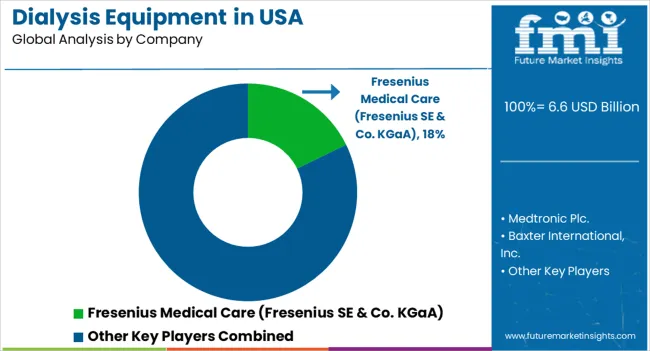
Top manufacturers of dialysis equipment in the United States are focusing on developing technologically advanced solutions with enhanced features. They are also expanding their footprint by adopting strategies like partnerships, acquisitions, mergers, and alliances.
Recent Developments in the United States Dialysis Equipment Business
| Attribute | Details |
|---|---|
| Estimated Size (2025) | USD 6.6 billion |
| Projected Value (2035) | USD 8.8 billion |
| Anticipated Growth Rate (2025 to 2035) | 2.9% CAGR |
| Forecast Period | 2025 to 2035 |
| Historical Data Available for | 2020 to 2025 |
| Industry Analysis | USD Million for Value |
| Key Regions Covered | Northeast, Midwest, Southeast, Southwest, and West |
| Key States Covered | New York, New Jersey, Massachusetts, Minnesota, Wisconsin, North Carolina, South Carolina, Florida, Virginia, Louisiana, Oklahoma, Texas, Washington, California, and New Mexico |
| Key Segments Covered | Product, Indication, modality, End User, and Region |
| Key Companies Profiled | Medtronic Plc.; Baxter International, Inc.; B. Braun Melsungen AG; Asahi Kasei Corporation; Fresenius Medical Care (Fresenius SE & Co. KGaA); Nipro Corporation; Toray Medical Co. Ltd. (Toray Industries, Inc.); Allmed Medical Care; Dialife S.A; ESCO Medicon; Quanta Dialysis Technologies; Nikkiso Co.,Ltd.; JMS Co. Ltd.; NxStage Medical, Inc.; NephroCan Holdings Corporation; Advin Urology |
| Report Coverage | Business Forecast, Competition Intelligence, DROT Analysis, Key Dynamics and Challenges, Strategic Growth Initiatives |
The global dialysis equipment industry analysis in the United States is estimated to be valued at USD 6.6 billion in 2025.
The market size for the dialysis equipment industry analysis in the United States is projected to reach USD 8.8 billion by 2035.
The dialysis equipment industry analysis in the United States is expected to grow at a 2.9% CAGR between 2025 and 2035.
The key product types in dialysis equipment industry analysis in the United States are hemodialysis devices, _hemodialysis machines, _dialyzers and filters, _vascular access devices, peritoneal dialysis devices, _automated peritoneal dialysis machine, _dialyzers and filters, _vascular access devices and continuous renal replacement therapy systems.
In terms of indication, chronic kidney disease (ckd) segment to command 41.2% share in the dialysis equipment industry analysis in the United States in 2025.






Full Research Suite comprises of:
Market outlook & trends analysis
Interviews & case studies
Strategic recommendations
Vendor profiles & capabilities analysis
5-year forecasts
8 regions and 60+ country-level data splits
Market segment data splits
12 months of continuous data updates
DELIVERED AS:
PDF EXCEL ONLINE
Dialysis Device and Concentrates Market Growth - Trends & Forecast 2025 to 2035
Dialysis Induced Anemia Treatment Market Analysis - Size, Share, & Forecast Outlook 2025 to 2035
Dialysis Equipment Market Insights - Growth & Forecast 2025 to 2035
Hemodialysis and Peritoneal Dialysis Market Analysis – Size, Share & Forecast 2024-2034
Home Dialysis Systems Market Size and Share Forecast Outlook 2025 to 2035
Continuous Ambulatory Peritoneal Dialysis Bags Market Size and Share Forecast Outlook 2025 to 2035
Equipment Management Software Market Size and Share Forecast Outlook 2025 to 2035
Equipment cases market Size and Share Forecast Outlook 2025 to 2035
Golf Equipment Market Size and Share Forecast Outlook 2025 to 2035
Port Equipment Market Size and Share Forecast Outlook 2025 to 2035
Farm Equipment Market – Advanced Agricultural Machinery 2024-2034
Pouch Equipment Market Growth – Demand, Trends & Outlook 2025 to 2035
Subsea Equipment Market Size and Share Forecast Outlook 2025 to 2035
Pavers Equipment Market Size and Share Forecast Outlook 2025 to 2035
Tennis Equipment Market Analysis - Size, Share, and Forecast Outlook 2025 to 2035
Galley Equipment Market Analysis and Forecast by Fit, Application, and Region through 2035
Garage Equipment Market Growth – Trends & Forecast 2024-2034
Mining Equipment Industry Analysis in Latin America Size and Share Forecast Outlook 2025 to 2035
General Equipment Rental Services Market Size and Share Forecast Outlook 2025 to 2035
RF Test Equipment Market Size and Share Forecast Outlook 2025 to 2035

Thank you!
You will receive an email from our Business Development Manager. Please be sure to check your SPAM/JUNK folder too.
Chat With
MaRIA